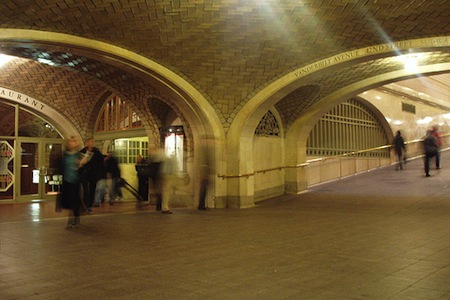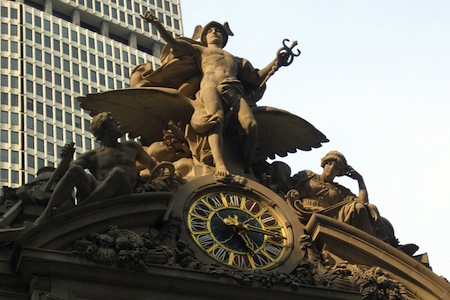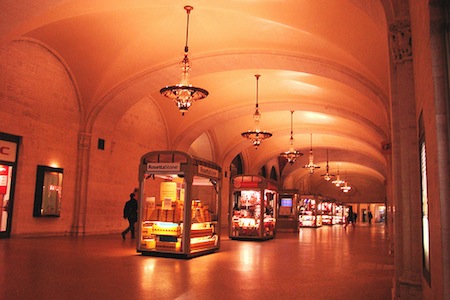The World's Train Station: Grand Central

Grand Central Terminal at night. Credit: Wiki Commons.
 Sam Roberts, a native Brooklynite, has been a journalist in New York City for nearly forty years, first at the New York Daily News, then at the New York Times, where he has been urban affairs correspondent since 2005. He is the author of numerous books on New York and American history and culture, including Who We Are -- A Portrait of America, the follow-up Who We Are Now, The Brother: The Untold Story of the Rosenberg Case, and most recently Grand Central: How a Train Station Transformed America, a history of Grand Central Station.
Sam Roberts, a native Brooklynite, has been a journalist in New York City for nearly forty years, first at the New York Daily News, then at the New York Times, where he has been urban affairs correspondent since 2005. He is the author of numerous books on New York and American history and culture, including Who We Are -- A Portrait of America, the follow-up Who We Are Now, The Brother: The Untold Story of the Rosenberg Case, and most recently Grand Central: How a Train Station Transformed America, a history of Grand Central Station.
The current Grand Central Terminal is celebrating the centennial of its opening on February 2. To mark the event, I spoke with Mr. Roberts earlier this week about his book and the history of Grand Central.
Just a week ago I took a short tour of Grand Central that was sponsored by the Institute of Classical Architecture, led by architectural historian Francis Morrone, and he mentioned that one of his favorite Grand Central stories is of jazz legend Charles Mingus and how he would bring his bass down to what we now call the “whispering gallery” because of the acoustics (it's in front of the Oyster Bar), and that he also proposed to his wife there. Do you have a favorite story or anecdote from Grand Central’s history?

The Whispering Gallery. Credit: Flickr/I like.
Well, the favorite one of mine, actually, is one I experienced when I was a kid. My father would take me along to the city and on one trip to Grand Central I was standing on the platform and looking up at this giant gleaming locomotive and the engineer leaned out the window and said, “Hey, do you want to drive this thing?”
I must have been agape, just open-mouthed. He beckoned me up and sat me on his lap and put my hand on the throttle and, you know, we moved the engine, which to me seemed like a mile (it was probably like only a foot and a half) but I said to myself, “My God, I’m driving this locomotive in the middle of Grand Central Terminal!” Ever since then I’ve just had such an enormous affection for the place.
Grand Central is such a place that you take for granted that -- I thought that I knew everything there was to know about it before I started researching my book, but I kept learning more and more as my research went on, talking to people, reading histories, and just roaming through the terminal.
When I started the book, it had (and still has) the subtitle "How a Train Station Transformed America." I went home [after that meeting with my publisher] and I said, “My God, am I going to be able to deliver on this? Did it really transform America?” But's so iconic, it was so transformative on any number of levels... It's certainly a cultural icon, in movies from North by Northwest to current TV shows like Mad Men. You can go anywhere around the world and say “This place is like Grand Central Station” and everybody knows what you mean. The notions of [urban] development, of urban planning, of air rights, monetizing air rights, and landmark preservation all really began at Grand Central. Standard Time began at Grand Central; I didn’t realize that when I started researching the book. The civil rights movement, you could argue, was nurtured there through A. Philip Randolph and the Sleeping Car Quarters Brotherhood. There’s just so much in terms of urban planning and development and American culture that I really think it does live up to the subtitle, more than I ever expected.
Any myths about Grand Central that you’d like to debunk?
Well, I mean, there are a couple things that are hard to prove or disprove. Is that boxcar that’s under the Waldorf Astoria really FDR’s car or not? You can hear both sides of that story and I don’t think it really matters. What is certainly provable and true is that FDR did use a siding that was directly under the Waldorf -- in part because of security reasons, in part to avoid congestion, and in part to hide from the American public that he had polio. (And I also learned is that whenever the president is in town and staying at the Waldorf -- even to this day -- the train is kept running and at the ready on that siding in case they need an emergency means of egress from the middle of Manhattan.)

The clock on 42nd Street. Credit: Flickr/wallyg.
Is that the largest display of Tiffany glass on the clock in front of the terminal on the 42nd Street facade? Well, Tiffany could not confirm that for me, so it’s hard to tell. They didn’t deny it, but they [couldn't confirm it], either.
So there are things like that, but there are so many secrets that I discovered. The station was, in a way, started by an accident, by a fatal train crash in 1902, when the railroads and the public realized that you could not run coal-burning locomotives in the middle of Manhattan because, among other things, the smoke obscured the vision of the engineers, thus the switch to electric railroads. William Wilgus the chief engineer of the New York Central, was absolutely instrumental in railroad electrification, and that changed the face of Manhattan. For one thing, it allowed the Pennsylvania Railroad to come in and build a station on the West Side, because now trains could go in a tunnel under the river, and it also allowed the New York Central to deck over that vast trench in the middle of Manhattan, the train yards, and create billions of dollars of real-estate through the air rights over the train yards.
I recently came across the Works Progress Administration mural by Edward Trumbull in the Graybar passage...

The Graybar Passage. Credit: Flickr.
It’s just great, and how the Graybar got its name, and looking at that clock in the Graybar Passage that is only right half the year, because it says Eastern Standard Time on it. New York Central was so proud of the fact that Standard Time had begun at Grand Central that Eastern Standard Time was etched into the wall under the clock even though, of course, for more than half of the year it’s wrong because it’s Daylight Savings Time.
We talked a little bit about the subtitle of your book. Do you think that there are any ways that America transformed Grand Central?
I think less so than the reverse. I mean, Grand Central was the gateway to New York and from the rest of the continent, and certainly New York’s the gateway to the continent. I think it was always a pretty democratic place. I mean, obviously, to travel from there you had to be able to afford a train ticket, but anyone could go there, anyone could partake of its majesty, of the cathedral-like setting, whether you were coming from the subway or coming from the suburbs.
Grand Central is this magnificent building, originally built by private enterprise and then lovingly restored by enlightened self-interest on the part of the Public Authority, and I just think it had such effect on urban planning, on culture. Joan Didion wrote that her first image of New York was listening to the radio program,Grand Central Station, where a million lives intersect, and it just created this image of New York as this almost mythical, Oz-like city that was implanted in people’s imaginations all over the country and, I think, all over the world.
If your only knowledge of Grand Central comes from after the renovations of the mid-1990s, you'd be hard pressed to picture how far into disrepair the Terminal had fallen.
It was terrible. It was not some place where you'd want to linger. It was a terrible time both for the city and the terminal as well, but after Metro-North took over they were determined to rescue it and they really did. It’s interesting, when you talk about government action and preserving it as a landmark and the role of Jackie Onassis, and I didn’t realize how close we came to losing the terminal because the city had all but decided not to appeal the judges' decision voiding the landmark designation, and she was instrumental with lawyers for the city and galvanizing a public groundswell that I think was vital in saving Grand Central and carrying the case all the way up to the Supreme Court.
It’s interesting that we actually ended up losing buildings that surrounded Grand Central, which were once part of the station.
Some we lost to real estate development, and we may lose more now that if the Midtown rezoning goes through. There are still great buildings there, like the Roosevelt Hotel, the Yale Club, and others that are just terrific, but that area has changed. What was so interesting is that WiIliam Wilgus, the chief engineer of the New York Central, envisioned it as a city within a city. Terminal City is what he called it, and it had a more profound effect on urban planning and the development in Midtown than Penn Station did. For all the glory of Penn Station, it had very little impact on the neighborhood in which it was situated, whereas Grand Central shifted the entire center of gravity of Midtown.
Today, Grand Central is, for all practical purposes, as much of a retail space as it is a transit hub. Do you think this has an effect on people’s connection with the space?
Well, you’ve got to remember that there are more passengers using Grand Central now than ever before. When the terminal was originally opened in 1913, there was a projection that someday nearly 100 million passengers would use it every year, and we're approaching that figure now. Metro-North is now the largest commuter railroad in the United States. The Long Island Railroad will eventually be coming in with the East Side Access Project. You have something like 750,000 people passing through the terminal for one reason or another during the day. So you can go in Grand Central and function in Grand Central without ever seeing a train, but I think train traffic and commuters are still integral to why it exists.
Currently, there are plans to renovate the New York Public Library and , of course, there is the plan to convert the Farley Post Office near the site of the old Pennsylvania Station into a transit hub. What do you think can be learned from the renovation of Grand Central that can be applied to these future projects?
Well, what I think can be learned is to do it right. Metro-North almost spared no expense, which is really remarkable for a public agency. They meticulously reconstructed things, they took care of the basics like fixing the leaky roof, but then they went beyond that.
What’s amazing is that a place built one hundred years ago functions as well as it does today. One of the things I love to do is stand on one of the balconies and look at the Main Concourse, and I watch the urban ballet of people scurrying all over the terminal. I’ve almost never seen anyone bump into each other.
Another thing I discovered in doing the book, too, is that what I tried to do is sort of a biography of the building. It’s not just marble, and steel, and glass, it’s the people who work there, the people who built it: William Wilgus the engineer; Audrey Johnson, who fields customer questions in the information booth; and Jackie Onassis, who was instrumental in saving it. Peter Stengel, who is head of the Metropolitan Transit Authority, made a personal and professional commitment to restoring this place to its original glory. And it was glorious. What’s interesting is there was no real reason that it had to be. Nobody required the New York Central to build it, the passenger service was relatively a minor source of revenue to the railroad compared to freight, but for a couple of reasons, not the least of which was Penn Station being built across town, they decided they were going to make this a monument to transportation, a monument to commerce, that was open to everyone, and thank goodness they did so, and that we got to keep it.
It’s interesting, you were mentioning, the people who work at Grand Central. I just recently learned through reading your blog that Grand Central has a landlord.
Yes, it does!
What do you think the future holds in the next 100 years for Grand Central?
Well, I think it’s pretty bright. When you look at the fact that it has reinvented itself. Long distance train travel pretty much ended a decade ago, but their number of commuters is growing, it will grow even more with the Long Island Railroad. The density of Midtown will presumably grow with the rezoning, and it has become a destination in itself. You talk about a terminal and that sounds like an end or endings, but this is place of new beginnings, not the least of which is the reinvention of Grand Central itself.
